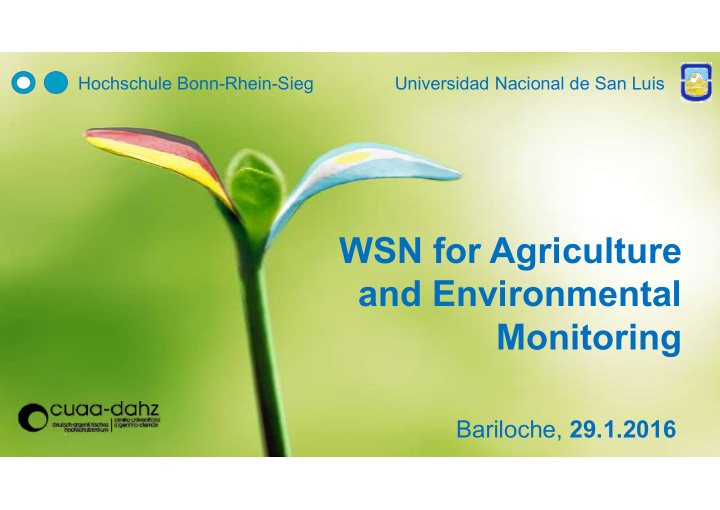



Hochschule Bonn-Rhein-Sieg Universidad Nacional de San Luis WSN for Agriculture WSN for Agriculture and Environmental Monitoring Bariloche, 29.1.2016
HBRS UNSL WSNs for Agriculture and Environmental Monitoring Why WSN for Agriculture? The need for more and better food production Trends in agriculture WSN in that context Why are WSN for Agriculture different than other WSNs? Why are WSN for Agriculture different than other WSNs? Application-specific constraints WSN Building blocks The Binational Master Program Innovation through interdisciplinary/intercultural projects. Specific projects as condensation nuclei The Partners: HBRS, UNSL, INTA, IMTEK, Fraunhofer-FIT, Promoting joint work: CUAA-DAHZ 2
HBRS UNSL The need for more and better food production Growning Demand Climate Change Food Safety Ethical Issues 3
HBRS UNSL Agriculture frontier expansion 1960 2013 1987 monte bajo monte bajo cultivos pastizal pastizal rastrojos cultivos cultivos rastrojos rastrojos 0 5000 m 4
HBRS UNSL Trends in Agriculture Neolithic Revolution: From nomadic to sedentary Plant and animals domestication Irrigation 5
HBRS UNSL Trends in Agriculture Green revolution: Monoculture/weed control Monoculture/weed control Irrigation infrastructure Pesticides Machinery 6
HBRS UNSL Trends in Agriculture The new green revolution: GMO Precision agriculture: Precision agriculture: ambience dependent Seeding fertilizing/pesticide application Direct Seeding (not plowing) Scales 7
HBRS UNSL Trends in Stockbreeding In the past… 8
HBRS UNSL Trends in Stockbreeding In the past… 9
HBRS UNSL Trends in Stockbreeding In the past… 10
HBRS UNSL Trends in Stockbreeding Now… 11
HBRS UNSL Trends in Stockbreeding Soon… Precision Stockbreeding 12
HBRS UNSL Then… Why WSN for Agriculture? One of the most important supply in precision agriculture is Information . This Information can be obtained from: This Information can be obtained from: • remote sensing: – Aerial / Satellite Multispectral Imaging – Meteorological radars • Local sensing – Soil sampling, analysis and mapping – Seeding/Crops monitoring – Local measurm. for remote sensors calibration 13
HBRS UNSL Then… Why WSN for Agriculture? Usage: • Food Traceability • Product Identity • • Eco-labeling Eco-labeling Water, energy, and carbon footprint • Consumer awareness • Value Chain coordination / Logistics • Early warning of hazards (frosts, hale, plagues, fires) • Thievery protection 14
15
HBRS UNSL Why are WSN for Agriculture different than other WSNs? Application-specific constraints - Energy availability - Bigger distances between nodes / RF Link - Bigger distances between nodes / RF Link - Harsh environment - Need for user friendly system design 16
HBRS UNSL Choosing the right WSN Building blocks Hardware Software • • MCU FSM / RTOS 8/16/32 bits? Complexity I/O capabilities Modularity DMIPS/Mhz vs. mW/Mhz DMIPS/Mhz vs. mW/Mhz Robustness Robustness Toolchain / Programming /Simulations Portability Long Term Support • Communication Protocols • Transceivers Responsiveness vs. Energy Efficient Tx Power / Sensitivity Robust Power consumption Tx/Rx Scalable BER/PER Standard • Batteries/Energy Harvesting 17
HBRS UNSL The Binational Master Program in Electronic Systems Design for Agriculture Why should Agricultural and Electrical Engineers work together (and understand each other's jargon). Innovating through interdisciplinary/intercultural projects. Innovating through interdisciplinary/intercultural projects. Specific projects as condensation nuclei The Partners: HBRS, UNSL, INTA, IMTEK, Fraunhofer-FIT, UniBonn Promoting joint work: CUAA-DAHZ (.org) 18
HBRS UNSL The Binational Master Program in Electronic Systems Design for Agriculture 1º Semester 2º Semester 3º Semester 4º Semester Bioquemical Fundations Physics Advanced of Agriculture Mathematics Agriculture Production Agriculture Production Advanced Control Advanced Control Systems Sensors y Actuators Markets and Embedded Systems Master Thesis Sustainability Digital Signal Information Systems for Distributed Systems Processing Agriculture 19 Master Project 1 Master Project 2 Master Project 3
HBRS UNSL The Binational Master Program in Electronic Systems Design for Agriculture First cohort 20
HBRS UNSL The Binational Master Program in Electronic Systems Design for Agriculture First cohort 21
HBRS UNSL IMTEK . 22 22
HBRS UNSL IMTEK .. 23
HBRS UNSL Next: BMBF – Mincyt ADA-WSN 2016 AP 1: system definition: • Responsible: HBRS / IMTEK • Partners involved: HBRS, IMTEK, UNSL, INTA, SEW, TEL • MP1: Final version of the functional specification of the system. • The aim is to create a detailed functional specification interfaces. This functional specification clear network structure for the selected application (probably two or three specification clear network structure for the selected application (probably two or three levels) will be detailed. AP2: Development of individual components, Simulation Tools and Protocols • Responsible: HBRS / IMTEK • Partners involved: HBRS, IMTEK, UNSL, SEW, TEL • In this access point components and tools will be developed. These are made up of clearly defined "functional modules" which are developed independently by the partners involved. 24
HBRS UNSL Next: BMBF – Mincyt ADA-WSN 2017 AP 3: Integration and Field Testing • Responsible: UNSL • Partners involved: HBRS, IMTEK, UNSL, INTA, TEL • In this work package, individual, such as leaf-nodes with sensor connection, router, gateway, components are integrated as a complete system and be carried out gateway, components are integrated as a complete system and be carried out sequentially appropriate field trials. AP 4: Data Analysis, Conclusion and Prospects • Responsible: UNSL • Partners involved: HBRS, IMTEK, UNSL, INTA, TEL • Upon project completion, a final workshop is scheduled in the EEA INTA Anguil in which analyzes and discusses the results obtained. The goal is a common final document summary, conclusions and prospective 25
HBRS UNSL Next: BMBF – Mincyt ADA-WSN 2017 AP 3: Integration and Field Testing • Responsible: UNSL • Partners involved: HBRS, IMTEK, UNSL, INTA, TEL • In this work package, individual, such as leaf-nodes with sensor connection, router, gateway, components are integrated as a complete system and be carried out gateway, components are integrated as a complete system and be carried out sequentially appropriate field trials. AP 4: Data Analysis, Conclusion and Prospects • Responsible: UNSL • Partners involved: HBRS, IMTEK, UNSL, INTA, TEL • Upon project completion, a final workshop is scheduled in the EEA INTA Anguil in which analyzes and discusses the results obtained. The goal is a common final document summary, conclusions and prospective 26
HBRS UNSL Next: BMBF – Mincyt ADA-WSN UAV? Baloons? 27
Recommend
More recommend